Most of the unpleasant pain in the lumbar region and spine is associated with a disease such as osteochondrosis. About 40% of men and women between the ages of 30 and 40 and about 90% of the elderly are affected. Therefore, the earlier the disease is diagnosed, the more thoroughly the patient is examined, the more likely it is to stop the development of osteochondrosis and continue to function at an older age.
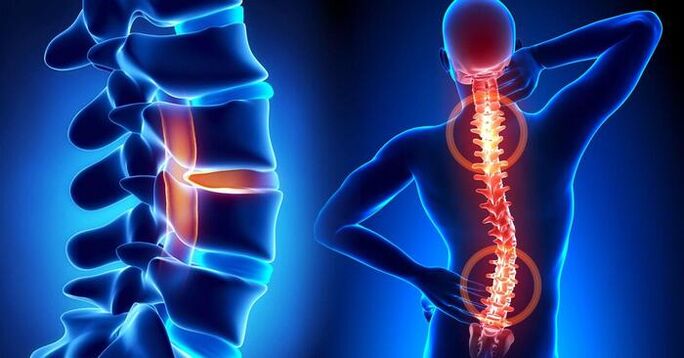
Definition of the disease, the cause of the disease
So, what is osteochondrosis, where does it develop, what structures are affected, what is the treatment? The disease affects the tissues between the spine and vertebrae and is characterized by a violation of their shape, density, elasticity and sometimes even integrity. As a result, the distance between the vertebrae decreases, the spine gradually loses its stability, nerve compression, the formation of hernias may develop, which is accompanied by back pain and discomfort during movement.
Briefly, the essence of osteochondrosis is the gradual erosion of the tissues of the intervertebral discs (cartilage), which leads to instability of the spine. When left untreated, degeneration of ligaments and joints develops, osteophytes appear, posture is impaired, and movements are accompanied by pain.
Causes of spinal osteochondrosis:
- a sedentary lifestyle with a lack of muscle load;
- spinal cord injury;
- systemic intense stress on the spine;
- heredity;
- overweight;
- hypothermia;
- hormonal and autoimmune diseases;
- toxic poisoning;
- congenital connective tissue deficiency;
- psychosomatic causes (stress, depression, etc. ).
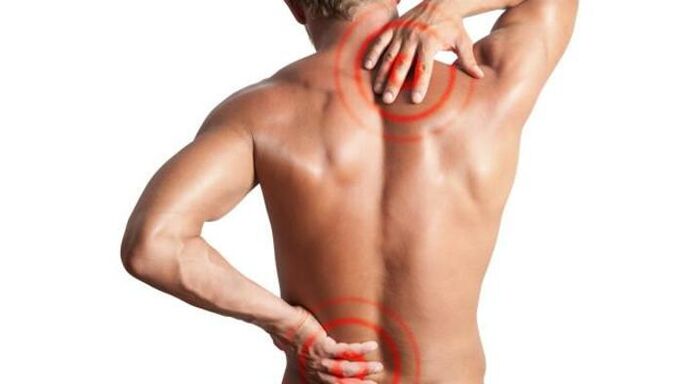
Symptoms of osteochondrosis
The disease is characterized by periods of remission and exacerbation with varying degrees of severity of symptoms. The main symptoms of spinal osteochondrosis, the main types of the disease, are characteristic of the spine, cervical and thoracic:
- pain localized in a certain area of the lower back;
- reflex pain syndrome associated with damage to nearby musculoskeletal tissues;
- myelopathy and radiculopathy caused by compression of the nerve endings of the spinal cord and blood vessels.
The list of symptoms of osteochondrosis can vary depending on which part of the spine is affected by the disease. Namely: patients report tingling in the muscles, numbness in the extremities, other sensory disorders, loss of strength in the arms and legs, headache and heart pain, back pain.
Pathogenesis of osteochondrosis
Before the elastic fibrous nucleus of the intervertebral disc begins to lose elasticity and deform, a number of processes involving osteochondrosis take place in the human body:
- spasms, dystonia, inflammation;
- decreased blood circulation;
- damage to nerve cell processes.
In addition, cracks appear in the deformed ring, disc protrusion develops and a hernia is formed. Typically, these thought-provoking factors of spinal disease develop during childhood or adolescence and are often the result of poor posture, scoliosis, sports injuries, infectious diseases, or congenital vascular disease.
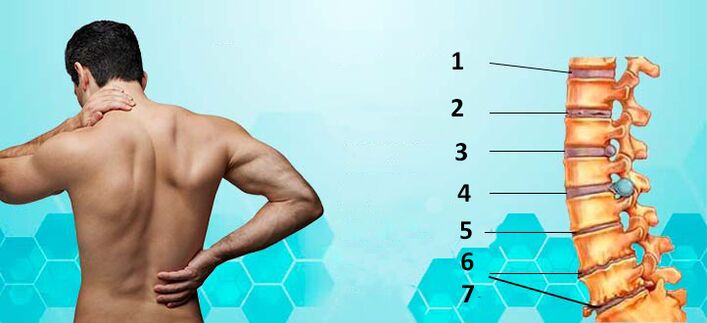
Stages of osteochondrosis
There are three stages in the development of osteochondrosis of the spine:
- the height of the intervertebral disc begins to decrease, it takes a flat shape, loses moisture, elasticity, can come out;
- the second develops in the absence of treatment and manifests itself with a violation of the structure of the fibrous ring of the vertebral disc, the appearance of cracks and the development of instability in a particular area of the spine;
- It is characterized by rupture of intervertebral cartilage, the development of hernia, the formation of bone processes in osteophytes.
The symptoms of osteochondrosis of the spine are more severe from the first to the third stage.
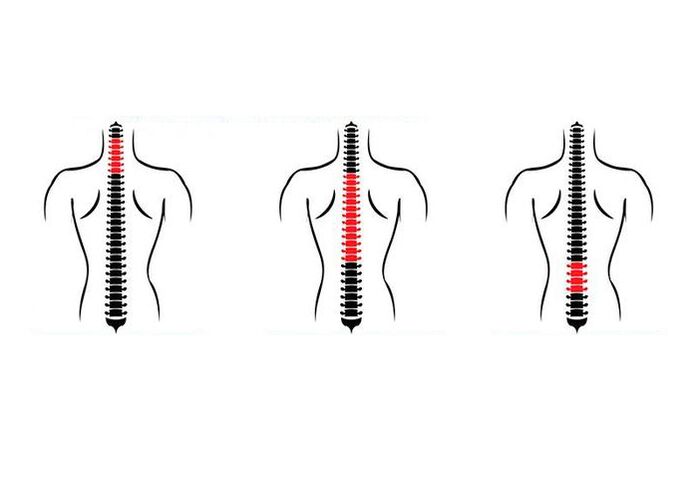
Classification of osteochondrosis
The classification of osteochondrosis is based on several symptoms, the first of which is the zone of localization. Distinguish:
- lumbar osteochondrosis;
- cervical lumbar osteochondrosis;
- thoracic lumbar osteochondrosis.
Osteochondrosis of the lumbar spine is manifested by pain in the lumbar region, which increases with turning the body and lifting weights. The pain can be transmitted to the foot, which is characterized as aching, or to both legs. Suspected of hernia with acute syndrome. Lumbar osteochondrosis, spasms in the muscles of the legs, peeling of the skin often occur.
Vertebrae 1-7 are affected by the development of lumbar osteochondrosis in the cervical spine. The disease is accompanied by headache in the back of the head, pain in the neck, neck bones, shoulders. A crisis is possible during dizziness, numbness of the upper extremities, a feeling of roundness in the throat.
The patient with lumbar osteochondrosis in the thoracic region is concerned about chest, shoulder, armpit and heart pain. Perhaps a feeling of shortness of breath, the development of intercostal neuralgic attacks.
Osteochondrosis of the lumbar spine is the most common, the rarest in the thorax.
Complications of osteochondrosis
If the patient thinks too late about the treatment of osteochondrosis, the following complications may develop when the symptoms of the disease become apparent:
- intervertebral hernia;
- spinal cord stroke;
- lumbar kyphosis;
- protrusion;
- radiculitis;
- paralysis of the lower extremities.
In the absence of treatment, the patient begins to suffer from regular exacerbations of the condition, characterized by increased pain, restriction of movement, which sharply worsens the general well-being. The most serious complication of spinal osteochondrosis is disability. Therefore, high-quality and timely treatment of osteochondrosis is needed to prevent such serious changes in the functioning of the musculoskeletal system.
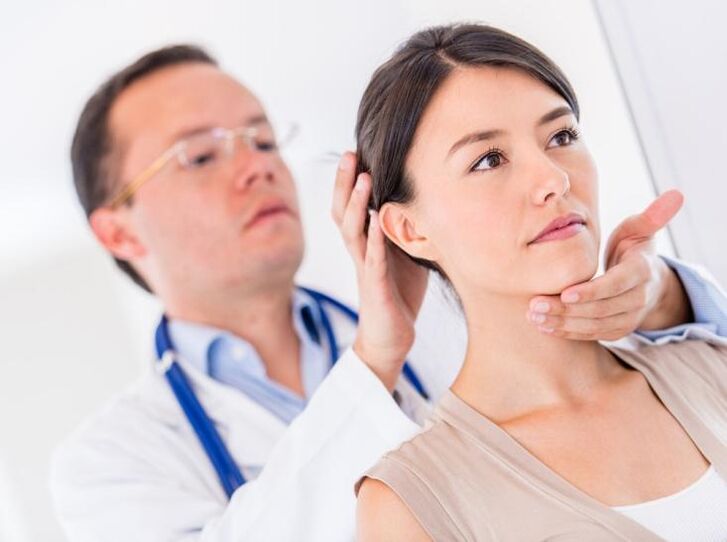
Diagnosis of osteochondrosis
A disease such as osteochondrosis is primarily a pain in the spine. However, it is important to distinguish between pain caused by problems other than degeneration of the intervertebral discs. To do this, doctors make a step-by-step diagnosis:
- Obtaining a medical historyFactors that contribute to the worsening of the condition is a conversation between a specialist and a patient to determine the exact area of pain localization. It is important to know the patient's occupation, the period of onset of spinal problems, what pain occurs during inflammation, back and other areas, what treatment methods the patient uses.
- Physiological examinationallows you to determine the proportions of the body, the quality of movements and movements, the condition of the skin, the degree of sensitivity to pain. The doctor palpated the condition of the muscle tissue, seals, edema, etc.
- X-ray examination of the spine in two planesto visually assess the situation. Allows to determine the displacement of the vertebrae, the presence of osteophytes, salt deposits.
If the information collected is not enough to prescribe treatment, or if you suspect a serious pathology of the spine, the patient is prescribed CT and magnetic resonance imaging, which allows a detailed examination of the vertebrae, vessels, soft tissues. determines treatment tactics to create a complete picture of the condition of the tissues, nerve processes and the spine affected by osteochondrosis.
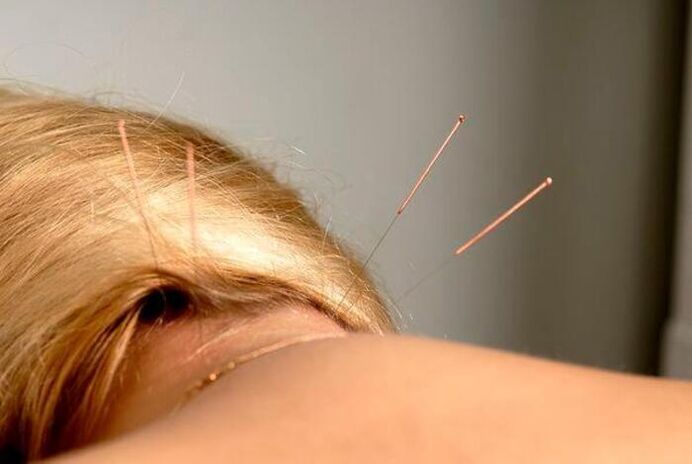
Treatment of osteochondrosis
Like any disease, osteochondrosis requires determining the cause of its development. Reducing the severity of symptoms is not the main, but an important stage of treatment, the outcome of which depends on many factors. In some cases it is a complete cure, in others it is the prevention of complications and disability.
A number of measures are used in the treatment of osteochondrosis of the spine:
- change the patient's daily routine;
- prescribe medication to reduce symptoms;
- physiotherapy procedures (massage, acupuncture, electrophoresis, exercise therapy, etc. ).
Changing the daily regimen in the treatment of osteochondrosis of the spine implies a reduction in the intensity of physical activity, bed rest with severe pain, the exclusion of sharp turns and bends.
Drugs for the treatment of osteochondrosis of the spine
They can be divided into several groups:
- Anti-inflammatory injections for painkillers, including tablets, injectable anesthetics and osteochondrosis. Homeopathic drug normalizes the function of the thyroid gland, improves lymphatic drainage, has anti-inflammatory, detoxifying and immunomodulatory effects.
- non-steroidal anti-inflammatory drugs. When used in patients with osteoarthritis, there is a decrease in the course of inflammatory and destructive changes in the joints, improvement of cartilage integrity, thickness and other properties, and stimulation of bone tissue regeneration.
- anti-inflammatory topical ointments and alternative transdermal patches. Such drugs have analgesic, anti-rheumatic, antipyretic and anti-inflammatory effects. The mechanism of action is to reduce the production of inflammatory mediators, reduce body temperature and pain.
- chondroprotectors;
- means for therapeutic analgesic blockades;
- B vitamins.
Additional treatments
The most effective of the additional tools that can be used to treat spinal and intervertebral discs, to alleviate the general condition and improve their function, are:
- acupuncture;
- magnetotherapy;
- to do professional massage and self-massage;
- physical education courses;
- hand therapy.
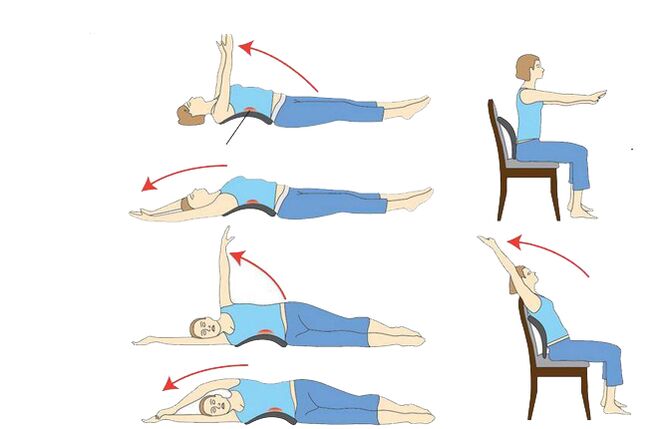
Prognosis, prevention
If spinal disease is not neglected and continues without serious complications, the condition can be significantly improved with 1, 5-2 months of competent treatment and the disease can be prevented from becoming chronic. In difficult cases, doctors recommend surgical treatment.
Prevention of osteochondrosis of the spine includes:
- change in body position and adhere to a proper daily routine of moderate physical activity;
- regular visits to the pool;
- body weight control;
- wear comfortable shoes;
- balanced diet;
- sleeping on an orthopedic pillow and mattress;
- to take deficient foods or prophylactic homeopathic medicines to increase immunity, improve overall health and eliminate dystonia.
After any pain in the spine, it is necessary to undergo a medical examination every year and consult a doctor for treatment.
Whichever osteochondrosis - lumbar, cervical or thoracic, to pay attention to their health, especially the entire musculoskeletal system - should become a good habit when it comes to the foundation of the spine.





































